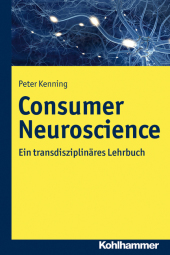Consumer Neuroscience: Ein transdisziplinäres Lehrbuch - Ein transdisziplinäres Lehrbuch
| Verlag | Kohlhammer |
| Auflage | 2014 |
| Seiten | 246 |
| Format | 23,2 cm |
| Gewicht | 426 g |
| ISBN-10 | 317020727X |
| ISBN-13 | 9783170207271 |
| Bestell-Nr | 17020727M |
\'Das junge Fachgebiet der Consumer Neuroscience verfolgt die Idee, neurowissenschaftliche Methoden, Theorien und Erkenntnisse in die Konsumenten- und Käuferverhaltensforschung zu integrieren. Damit sollen traditionelle verhaltenswissenschaftliche Ansätze ergänzt und neue Kenntnisse gewonnen werden. Das vorliegende Lehrbuch stellt vor diesem Hintergrund den aktuellen Stand der Consumer Neuroscience in leicht verständlicher Form dar. Zielgruppe des Buches sind Studierende, Nachwuchswissenschaftler aber auch interessierte Praktiker. Ihnen soll das Buch einen Einstieg in die Thematik sowie einen Überblick über die aktuellen Entwicklungen und Themengebiete geben.
Klappentext:
Recent years have seen enormous progress in academic research at the intersection of neuroscience, psychology and economics. The outcome of this progress is summarized by the introduction of new and transdisciplinary fields like neuroeconomics or decision neuroscience. Their joint aim is to integrate and apply neuroscientific theories, concepts, findings and methods to develop a sound theory of human behaviour. Against this background, the aim of this textbook is to give a detailed overview of the research area of consumer neuroscience. This transdisciplinary field can be viewed as a sub-discipline of neuroeconomics, in which consumer psychologists and business economists are dedicated to investigating consumer research and marketing questions with methodological and conceptual approaches from neuroscience. In addition they aim to add a new theoretical perspective to consumer research. Therefore, the academic research in consumer neuroscience takes place at the nexus of neuroscience, psychology, and marketing. Classical research in consumer behaviour and marketing necessarily looked at the human organism as being a >black box< and consequently used mainly theoretical constructs to interpret bodily processes and resulting behaviour. Today, modern techniques and methods from neuroscience enable researchers to get a more direct look into the "black box" of the human organism and provide the basis for the emergent field of consumer neuroscience. On the whole the use of neurobiological methods such as electroencephalography is not entirely new to consumer and marketing research. Nevertheless the direct observation of brain processes through methods such as functional magnetic resonance imaging (fMRI) provides a completely new and different perspective. To get an introduction to the field of consumer neuroscience, the textbook is organized as follows: After the introduction, chapter 2 elucidates major academic cornerstones that led to the emergence of the transdisciplinary field of consumer neuroscience and provides a clear-cut definition of the discipline in the end. Chapter 3 briefly presents basic knowledge about brain physiology and relevant anatomical terms and areas for consumer neuroscience. Chapter 4 provides an overview of recent methods in neuroscience used by consumer researchers. After a brief insight into selected theories and concepts from neuroscience that consumer researchers can benefit from (chapter 5), a variety of preliminary findings is detailed in chapter 6 and structured alongside the traditional marketing-mix elements and brand research. Finally, the chapter concludes with a look at the future of consumer neuroscience research.

